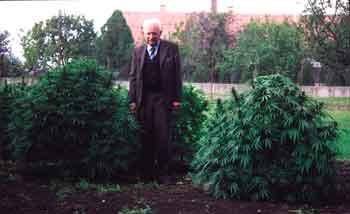inbred: A plant resulting from successive self-fertilization of parents throughout several generations gene
inbred line: A line produced by continued inbreeding; usually a nearly homozygous line originating by continued self-fertilization, accompanied by selection gene >>> Figure 51
inbred pure lines: Involves inbreeding of annual seed-propagated material; homogeneous and homozygous lines are isolated by selection of desired recombinants or segregates in F2 to F7 generations of crosses between parental pure lines (generally monogenotypic lines can be blended to form multilines, e.g., in tomato, lettuce, soybean, pea, cowpea, snapbean, field bean, Arabian coffee, Capsicum pepper, eggplant, okra, lentil, and papaya) meth >>> Figure 51
inbred-variety cross: The F1 cross of an inbred line with a variety meth >>> toppers >>> Table 37
inbreeding: The crossing of closely related plants; one important purpose of induced inbreeding is the development of genotypes that can be maintained through multiple generations of seed production; self-pollinated cultivars are reproduced for many generations by inbreeding; inbreeding is also used to reduce the frequency of deleterious recessive alleles in genotypes that serve as parents of a synthetic or a vegetatively propagated cultivar; inbreeding increases the genetic and phenotypic variability among individuals in a population; four mating systems are used to increase the homozygosity in a breeding population meth >>> Figures 50, 51
inbreeding coefficient: The probability that the two genes at any locus in a diploid individual are identical by descent (i.e., they originated from the replication of one gene in a previous generation) gene meth >>> Table 10
inbreeding depression:The reduction in vigor often observed in progeny from matings between close relatives; it is due to the expression of recessive deleterious alleles; it is usually severe in open-pollinated outcrossing species; an effect opposite to heterosis gene >>> heterosis
inbreeding load: The extent to which a population is impaired by inbreeding bio evol >>> Table 10
inbreeding population:>>> inbreeding
source : Dictionary of PLANT BREEDING -
Rolf H.J. Schlegel
www.internationalhempassociation.org/jiha/iha01215.html

inbred line: A line produced by continued inbreeding; usually a nearly homozygous line originating by continued self-fertilization, accompanied by selection gene >>> Figure 51
inbred pure lines: Involves inbreeding of annual seed-propagated material; homogeneous and homozygous lines are isolated by selection of desired recombinants or segregates in F2 to F7 generations of crosses between parental pure lines (generally monogenotypic lines can be blended to form multilines, e.g., in tomato, lettuce, soybean, pea, cowpea, snapbean, field bean, Arabian coffee, Capsicum pepper, eggplant, okra, lentil, and papaya) meth >>> Figure 51
inbred-variety cross: The F1 cross of an inbred line with a variety meth >>> toppers >>> Table 37
inbreeding: The crossing of closely related plants; one important purpose of induced inbreeding is the development of genotypes that can be maintained through multiple generations of seed production; self-pollinated cultivars are reproduced for many generations by inbreeding; inbreeding is also used to reduce the frequency of deleterious recessive alleles in genotypes that serve as parents of a synthetic or a vegetatively propagated cultivar; inbreeding increases the genetic and phenotypic variability among individuals in a population; four mating systems are used to increase the homozygosity in a breeding population meth >>> Figures 50, 51
inbreeding coefficient: The probability that the two genes at any locus in a diploid individual are identical by descent (i.e., they originated from the replication of one gene in a previous generation) gene meth >>> Table 10
inbreeding depression:The reduction in vigor often observed in progeny from matings between close relatives; it is due to the expression of recessive deleterious alleles; it is usually severe in open-pollinated outcrossing species; an effect opposite to heterosis gene >>> heterosis
inbreeding load: The extent to which a population is impaired by inbreeding bio evol >>> Table 10
inbreeding population:>>> inbreeding
source : Dictionary of PLANT BREEDING -
Rolf H.J. Schlegel
www.internationalhempassociation.org/jiha/iha01215.html
Last edited:





